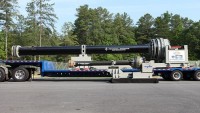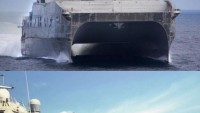Russia Tests its first EM Railgun but will use it to Study the Universe
| Arthur Dominic Villasanta | | Jul 13, 2016 10:53 AM EDT |
(Photo : US Navy) A railgun projectile is fired during the test of a US Navy EM railgun
Russia reported the first test of its homegrown electromagnetic railgun but allege this weapon will be used for science to uncover the mysteries of the universe and not as a weapon of war.
A team of Russian scientists from the United Institute of High Temperatures at the Russian Academy of Sciences (RAS) successfully tested Russia's first EM railgun that relies on electromagnetic forces to propel a projectile to hypersonic speeds. The railgun tests were conducted at the practice range of the institute's Shatura branch on the outskirts of Moscow.
Like Us on Facebook
The team reported firing projectiles at a velocity of 11 kilometers per second, enough to overcome gravity and reach Earth orbit. RAS President Vladimir Fortov said the railgun will help Russian scientists study matter at extremely high temperatures and pressure and understand how the Universe is organized.
China is also actively working on its own EM railgun. Chinese scientists have published some 150 articles on this issue last year.
"Our task is to try to obtain such high pressures in laboratory conditions with the help of such systems and study the behavior of matter at extremely high temperatures and pressures," said Fortov.
"This is needed to understand how the Universe is organized because 95% of the Universe's entire visible matter stays precisely in a strongly compressed and heated state. We're trying to obtain the states of matter with many millions of atmospheres with the help of these systems."
He noted a secondary aim is to study strikes by meteorites and comets against the surface of the Earth and satellites in order to protect space vehicles from the impact of high-velocity particles.
"This is also an uneasy task as the strikes of celestial bodies like the Tunguska meteorite develop the velocities of dozens of kilometers per second. Therefore, one of the tasks we're dealing with is to determine a crater shape and develop a protective system that would protect space vehicles from space debris, comets and meteorites," according to Fortov.
Fortov revealed that two fastening pins broke away from the railgun after a projectile weighing 2 grams was launched with a velocity of 3.2 km/s. Russian scientists are currently preparing the EM railgun to be capable of accelerating a projectile to hypersonic speeds.
Efforts to develop an EM railgun have been going on throughout the world for the past 50 years.
TagsRussia, electromagnetic railgun, Russian Academy of Sciences, Vladimir Fortov
©2015 Chinatopix All rights reserved. Do not reproduce without permission
EDITOR'S PICKS
-

Did the Trump administration just announce plans for a trade war with ‘hostile’ China and Russia?
-

US Senate passes Taiwan travel bill slammed by China
-

As Yan Sihong’s family grieves, here are other Chinese students who went missing abroad. Some have never been found
-

Beijing blasts Western critics who ‘smear China’ with the term sharp power
-

China Envoy Seeks to Defuse Tensions With U.S. as a Trade War Brews
-

Singapore's Deputy PM Provides Bitcoin Vote of Confidence Amid China's Blanket Bans
-

China warns investors over risks in overseas virtual currency trading
-

Chinese government most trustworthy: survey
-

Kashima Antlers On Course For Back-To-Back Titles
MOST POPULAR
LATEST NEWS
Zhou Yongkang: China's Former Security Chief Sentenced to Life in Prison

China's former Chief of the Ministry of Public Security, Zhou Yongkang, has been given a life sentence after he was found guilty of abusing his office, bribery and deliberately ... Full Article
TRENDING STORY

China Pork Prices Expected to Stabilize As The Supplies Recover

Elephone P9000 Smartphone is now on Sale on Amazon India

There's a Big Chance Cliffhangers Won't Still Be Resolved When Grey's Anatomy Season 13 Returns

Supreme Court Ruled on Samsung vs Apple Dispute for Patent Infringement

Microsoft Surface Pro 5 Rumors and Release Date: What is the Latest?














